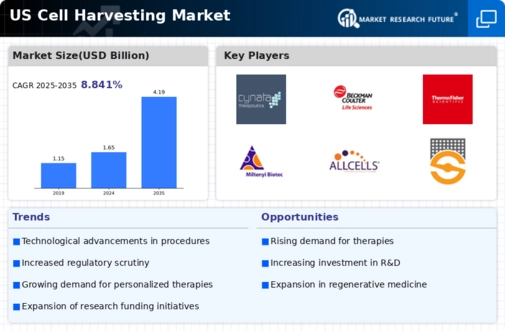Advancements in Stem Cell Research
The ongoing advancements in stem cell research are significantly influencing the cell harvesting market. As scientists uncover the potential of stem cells in regenerative medicine, the demand for effective harvesting techniques increases. Stem cells offer the possibility of treating various conditions, including neurodegenerative diseases and injuries, which further fuels interest in this area. The National Institutes of Health (NIH) has reported substantial funding for stem cell research, indicating a commitment to exploring its therapeutic applications. This investment is likely to enhance the capabilities of the cell harvesting market, as new methodologies and technologies emerge to isolate and manipulate stem cells more efficiently. Consequently, the market is expected to witness robust growth as researchers and clinicians seek innovative solutions to harness the power of stem cells.
Regulatory Developments and Support
Regulatory developments play a significant role in shaping the cell harvesting market. The US Food and Drug Administration (FDA) has been actively working to streamline the approval processes for cell-based therapies, which encourages innovation within the industry. Recent initiatives aimed at expediting the review of regenerative medicine products are likely to foster a more favorable environment for the cell harvesting market. As regulations evolve, companies may find it easier to bring new harvesting technologies to market, thereby enhancing competition and driving advancements. This regulatory support is crucial for the growth of the cell harvesting market, as it not only facilitates the introduction of novel products but also instills confidence among investors and stakeholders.
Rising Prevalence of Chronic Diseases
The increasing incidence of chronic diseases in the US is a pivotal driver for the cell harvesting market. Conditions such as cancer, diabetes, and cardiovascular diseases necessitate advanced treatment options, including cell-based therapies. As the population ages, the demand for innovative medical solutions rises, propelling the need for effective cell harvesting techniques. According to recent data, chronic diseases account for approximately 70% of all deaths in the US, highlighting the urgency for improved therapeutic strategies. This trend indicates a growing market for cell harvesting technologies, as healthcare providers seek to enhance patient outcomes through regenerative medicine. The cell harvesting market is thus positioned to expand significantly, driven by the need for efficient cell isolation and processing methods to support the development of targeted therapies.
Growing Investment in Biopharmaceuticals
The surge in investment within the biopharmaceutical sector is a crucial driver for the cell harvesting market. As pharmaceutical companies increasingly focus on developing biologics and cell-based therapies, the need for efficient cell harvesting processes becomes paramount. The biopharmaceutical market in the US is projected to reach over $400 billion by 2025, reflecting a strong trend towards biologics that require sophisticated cell harvesting techniques. This growth is likely to stimulate demand for advanced technologies that can streamline the harvesting process, ensuring high yields and purity of cells. The cell harvesting market stands to benefit from this trend, as companies seek to optimize their production capabilities to meet the rising demand for innovative therapies.
Increased Focus on Personalized Medicine
The shift towards personalized medicine is reshaping the landscape of the cell harvesting market. As healthcare providers aim to tailor treatments to individual patients, the need for precise cell harvesting techniques becomes increasingly important. Personalized therapies often require specific cell types, necessitating advanced harvesting methods to ensure the right cells are obtained. This trend is supported by a growing body of research indicating that personalized approaches can lead to improved patient outcomes. The cell harvesting market is likely to expand as healthcare systems invest in technologies that facilitate the customization of treatments, thereby enhancing the efficacy of therapies and aligning with the broader movement towards individualized healthcare.


















Leave a Comment